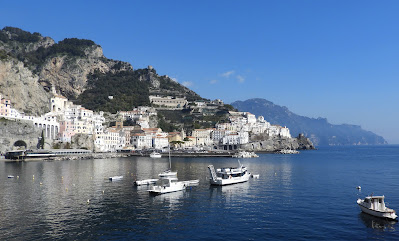 |
| Looking over Alberobello's 1500 trulli |
Across the Puglian landscape near Bari, you’ll find the unusual round houses with domed and pointed roofs called trulli. They’re built of limestone bricks and topped with limestone “shingles”, really just large, thin chips of stone. Greeks built a version of trullo 2000 years ago and Turks built something similar in Cappadocia. Mostly, in Puglia, the trullis were used for animal shelters, taking advantage of the building material prevalent in the area, limestone.
In the 1600’s, in an effort to avoid paying taxes to the Spanish Viceroy in Naples, the local Count ordered that all new houses be built of stone without mortar. Apparently that meant they weren’t really houses so couldn’t be taxed. Local people in Alberobello subsequently built trullis as their homes during the 17th century. There are 1500 trullis in Alberobello, creating a major, and charming, tourist attraction, and crowding the stone streets with tour groups during the high season. So now, the trullis are mostly shops, cafes and B and B’s. But, on our visit, it was February and chilly and quite empty.
 |
| Alberobello street |
May of the trulli have symbols painted on their roofs. These are to bring good luck and keep away the demons.
 |
| symbols to bring good luck |
Some of the trullis form cul de sacs. These developed when sons married and started
their own families, building their trullis next to those of their parents and
siblings. family cluster of trullis
One trulli is a “twin”, supposedly because two brothers fell in love with the same woman. One married her and, since they both lived in the same house, the successful brother built a wall in the middle of the trullo to keep his brother away from his new wife.
 |
| twin-roofed trullo |
We left Alberobello to visit a cheese farm, which was such a
fun visit. The owner showed us his dairy
cows and the piglets and their moms who live amongst them. Everybody looks quite happy, which makes our huge
pig farms, where animals are squashed together and never leave their tiny pens,
seem especially terrible.
Giorgio, the farmer, showed us his milking barn, with milking stations for 8 cows at a time, and his large vats where he heats the milk to make cheese. He makes several kinds of cheese, including mozzarella, which apparently takes a great deal of slapping and stretching to get to the best quality. We didn’t make cheese, but will do so if we bring a group to Puglia. Even though we didn’t do any work, he served us a delicious lunch of fresh, homemade bread, his sausages, several kinds of his cheese and tomato bruschetta. We tasted his own olive oil and wine, all of which made a perfect lunch.
 |
| contented cows |
Over lunch, our guide told us about her family. It’s quite an extraordinary story. She lived in Los Angeles for 10 years, attending
UCLA and working as a translator, but returned home when she realized the tug
of family and Italy.
 |
| and happy pigs |
She has two sons, the oldest her biological son who is a doctor. Her younger son she adopted about a year ago at the age of 21. He was in a Belorussian orphanage, not because he was an orphan, but because his parents abandoned him when he was a toddler. An Italian organization matches Belorussian orphans with Italian families so the children can spend 4 months a year, December and the summer months, with an Italian family. This relieves the orphanage of the need to feed the children for those 4 months and also lets them close during that time and cut costs. For the children, the advantages are obvious.
 |
| mozzarella |
 |
| Don and sausage |
Our guide said her son was malnourished when he arrived for
his first Christmas at the age of 6 and looked much better by the time he
returned to Belarus. Every year
thereafter, he arrived for Christmas and the 3 months of summer to stay with
them. They became a family of four
instead of three. After her Belarussian
son graduated from high school, she started trying to get him legal residency
in Italy so he could leave Belarus. lunch at the cheese farm
Ultimately,
she and her husband were able to legally adopt him, at considerable cost and
effort, but, even then, he barely made it out of the country because Belarus
now needs young men, presumably for the military. He was actually at the airport waiting to
board his flight to Italy when the Belarussian agents stopped him, demanding
more paperwork. Our guide said she was
able to get the paperwork, fax it to her lawyer in Belarus, and get her son on the
plane. He now lives with her and her
husband and is studying to get into the university here.





































